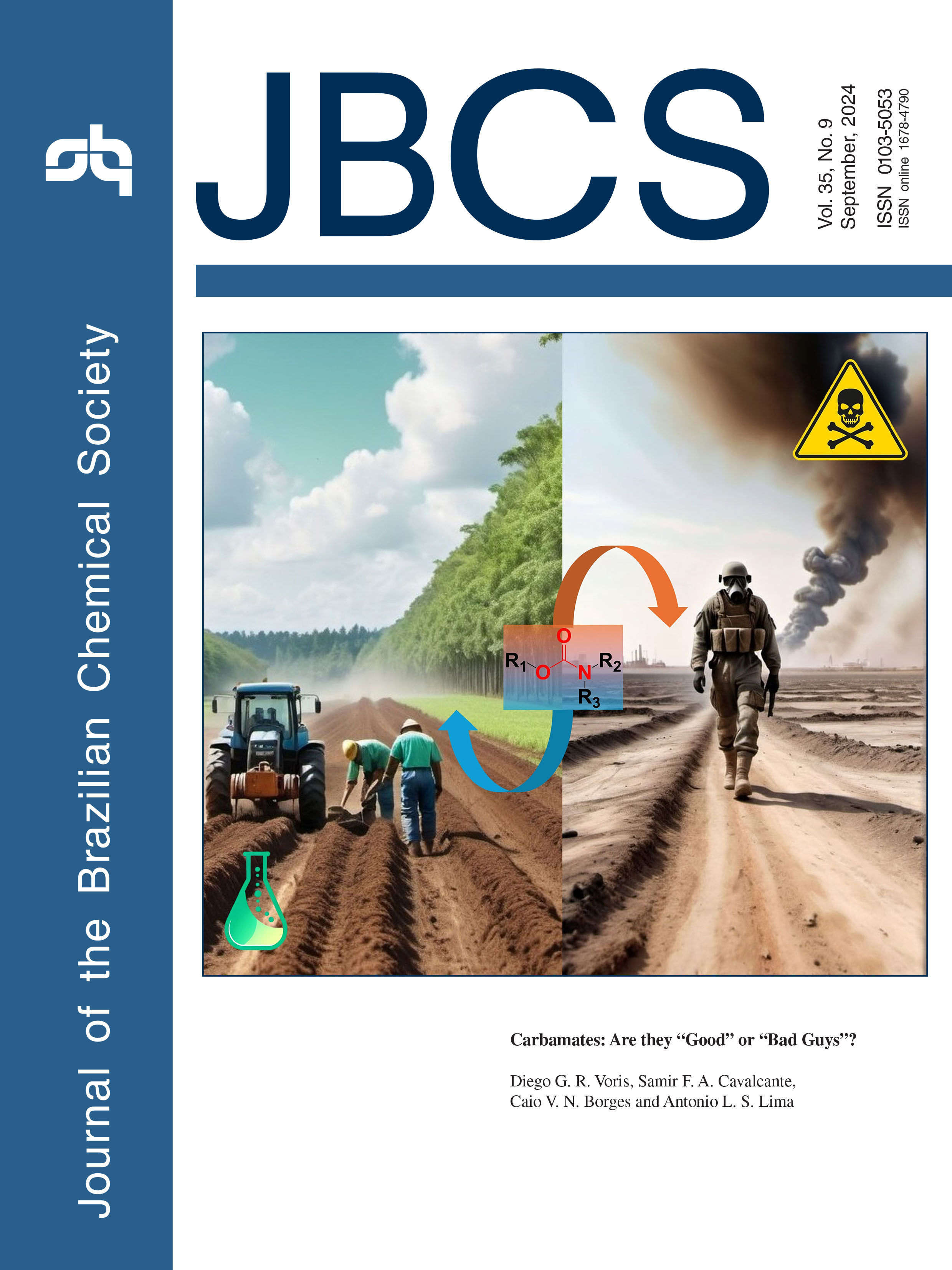vol. 35, No. 9, 2024
Carbamates are valuable compounds, albeit some of them can be hazardous. They may bring life and hope, as seen in relevant drugs and in agrochemicals that improve crop productivity through pest control. However, excessive use poses environmental and health risks. The inclusion of some carbamates in the Chemical Weapons Convention reminds of their toxicity and potential danger. Details are presented in the Review Carbamates: Are they "Good" or "Bad Guys"? by Diego G. R. Voris, Samir F. A. Cavalcante, Caio V. N. Borges and Antonio L. S. Lima on e-20240058.
Carbamates: Are they "Good" or "Bad Guys"?
Diego G. R. Voris  ; Samir F. A. Cavalcante
; Samir F. A. Cavalcante  ; Caio V. N. Borges
; Caio V. N. Borges  ; Antonio L. S. Lima
; Antonio L. S. Lima 
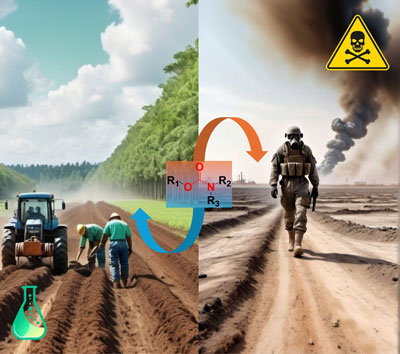
Carbamates are valuable compounds, albeit some of them can be hazardous. They may bring life and hope, as seen in relevant drugs and in agrochemicals that improve crop productivity through pest control. However, excessive use poses environmental and health risks. The inclusion of some carbamates in the Chemical Weapons Convention reminds of their toxicity and potential danger. Details are presented in the Review Carbamates: Are they "Good" or "Bad Guys"? by Diego G. R. Voris, Samir F. A. Cavalcante, Caio V. N. Borges and Antonio L. S. Lima on e-20240058.
https://dx.doi.org/10.21577/0103-5053.20240058
Review J. Braz. Chem. Soc. 2024, 35(9), e-20240042, 1-19
A Systematic Review of Tropospheric Ozone Modeling Using Community Multiscale Air Quality Model (CMAQ)
Thiago F. da Costa  ; Josie B. B. Carvalho
; Josie B. B. Carvalho  ; Rizzieri Pedruzzi
; Rizzieri Pedruzzi  ; Taciana T. A. Albuquerque; Eduardo M. Martins
; Taciana T. A. Albuquerque; Eduardo M. Martins

This critical review encompasses the analysis of studies from 2016 to 2023 that employ the Community Multiscale Air Quality Model (CMAQ) model for ozone simulation.
https://dx.doi.org/10.21577/0103-5053.20240042
J. Braz. Chem. Soc. 2024, 35(9), e-20240058, 1-14
Carbamates: Are they "Good" or "Bad Guys"?
Diego G. R. Voris  ; Samir F. A. Cavalcante
; Samir F. A. Cavalcante  ; Caio V. N. Borges
; Caio V. N. Borges  ; Antonio L. S. Lima
; Antonio L. S. Lima 
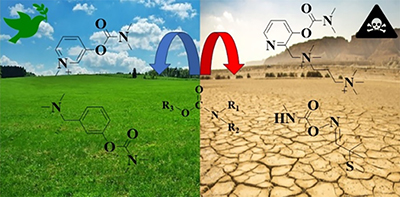
In this short review, we present how carbamates can be seen as "good guys" by their use in medicine (hope), or "bad guys", due to their misuse in pesticides and as chemical weapons (death).
https://dx.doi.org/10.21577/0103-5053.20240058
Articles J. Braz. Chem. Soc. 2024, 35(9), e-20240044, 1-10
Longitudinal Gradient and Historical Trends of Arsenic and Metals in a Tropical Reservoir
Roberta C. Salles; Rafael Mantovaneli  ; Luana S. Moreira
; Luana S. Moreira  ; Rubens C. L. Figueira
; Rubens C. L. Figueira  ; Geisamanda P. Brandão
; Geisamanda P. Brandão  ;
;
Gilberto F. Barroso  ; Renato Rodrigues Neto
; Renato Rodrigues Neto  ; Maria Tereza W. D. Carneiro
; Maria Tereza W. D. Carneiro 
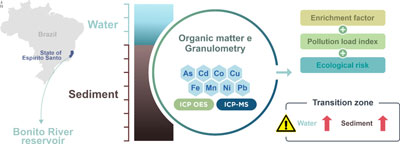
The study investigated the distribution of arsenic and metals in a Brazilian tropical reservoir over time. Elevated element concentrations were found in specific water and sediment zones. The sediment core dated back to 1940 and showed increasing element concentrations, emphasizing the need for ongoing monitoring.
https://dx.doi.org/10.21577/0103-5053.20240044
J. Braz. Chem. Soc. 2024, 35(9), e-20240045, 1-16
Effect of Fe3O4:RGO Ratios in Magnetic Nanocomposites Applied for Dye Discoloration
Arthur H. A. Gonçalves; Pedro H. C. Siciliano; Carla R. Moreira; Odivaldo C. Alves; Alexander Caytuero; Elisa M. B. Saitovitch; Fred. J. Litterst; Deborah V. Cesar;Cristiane A. Henriques  ; Alexandre B. Gaspar
; Alexandre B. Gaspar 
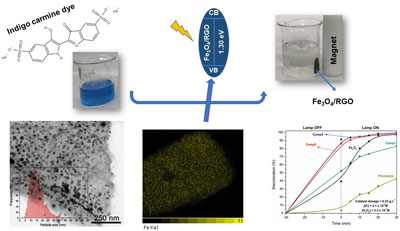
Simple prepared Fe3O4:RGO catalysts present high activity for indigo carmine dye photodegradation.
https://dx.doi.org/10.21577/0103-5053.20240045
J. Braz. Chem. Soc. 2024, 35(9), e-20240047, 1-8
LC-FLD Determination of Glyphosate, AMPA and Glufosinate in Surface Water from the Paraná River Basin
Renata P. Gabardo  ; Gilcélia A. Cordeiro
; Gilcélia A. Cordeiro  ; Patricio Peralta-Zamora
; Patricio Peralta-Zamora 
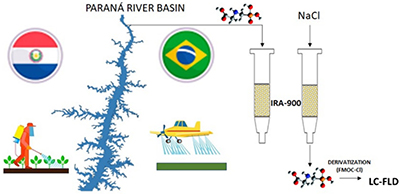
Pesticides extensively used in agriculture show a high potential for contaminating water bodies.
https://dx.doi.org/10.21577/0103-5053.20240047
J. Braz. Chem. Soc. 2024, 35(9), e-20240048, 1-16
Chitosan/Poly(2-(diisopropylamino)ethyl Methacrylate-Based pH-Sensitive Magnetic Composite for Application in Avermectins Adsorption in Aqueous Medium
Leila S. Teixeira; Stephanne Y. B. de Carvalho; Ana Cláudia dos Santos; Marcella M. C. Borges; Sara S. Vieira  ; Keyller B. Borges
; Keyller B. Borges  ; Luiz Gustavo L. Guimarães
; Luiz Gustavo L. Guimarães 
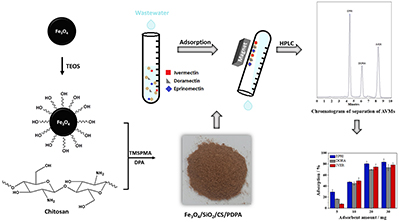
A composite material with magnetic and pH-responsive properties, consisting of chitosan/poly(2-diisopropylamino)ethyl methacrylate (Fe3O4/SiO2/CS/PDPA) was developed for application in avermectins adsorption in aqueous medium.
https://dx.doi.org/10.21577/0103-5053.20240048
J. Braz. Chem. Soc. 2024, 35(9), e-20240051, 1-10
Identification of Adulterants in Extra Virgin Olive Oil Using HS-SPME-GC-MS and Multivariate Data Analysis
Luana E. Knaul; Leticia Maria S. Santos; Priscila Maria M. Ramos; Martha B. R. Cabrera; André Luis Rüdiger; Marcelo N. Kapp;
Aline T. Toci; Marcela Boroski 
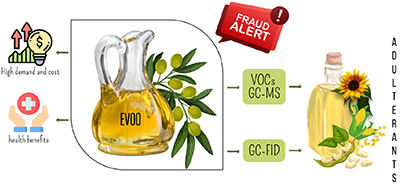
Fatty acids composition indicates lower cost vegetable oils as major source of adulteration, and discriminatory analysis using volatile organic compounds (VOCs) showed the presence of adulterant markers in the extra virgin olive oil (EVOO).
https://dx.doi.org/10.21577/0103-5053.20240051
J. Braz. Chem. Soc. 2024, 35(9), e-20240052, 1-9
Radioinduced Modulatory Response of Lipid Profiles of Wistar Rats Brain Monitored by DESI-MS Imaging
Matheus F. S. Mingote; Camila Cristina A. de Paula; Tarcísio P. R. de Campos; Géssica Adriana Vasconcelos; Boniek G. Vaz;
Rodinei Augusti 

Lipid images by desorption electrospray ionization mass spectrometry imaging (DESI-MSI) of brains of Wistar rats submitted to total body irradiation (TBI).
https://dx.doi.org/10.21577/0103-5053.20240052
J. Braz. Chem. Soc. 2024, 35(9), e-20240055, 1-11
Red Propolis: Chemical and Mid-Infrared Spectroscopic Characterization and Classification by Geographic Origin
Amanda B. S. de Lima  ; Thinara F. Oliveira; Marcondes V. da Silva; Sibelli P. B. Ferrão; Vítor V. S. de Almeida;
; Thinara F. Oliveira; Marcondes V. da Silva; Sibelli P. B. Ferrão; Vítor V. S. de Almeida;
Leandro S. Santos 
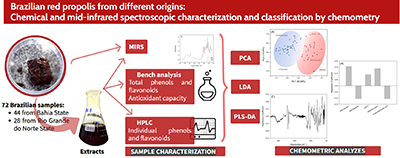
Brazilian red propolis from different origins: chemical and mid-infrared spectroscopic characterizations and classification by chemometrics.
https://dx.doi.org/10.21577/0103-5053.20240055
J. Braz. Chem. Soc. 2024, 35(9), e-20240057, 1-19
Dielectric Properties During Microwave-Induced Interesterification Reactions for Biodiesel and Triacetin Production
Jonas Miguel Priebe; Evandro L. Dall'Oglio  ; Leonardo G. de Vasconcelos; Paulo T. de Sousa Jr.; Andressa A. Ramos;
; Leonardo G. de Vasconcelos; Paulo T. de Sousa Jr.; Andressa A. Ramos;
Emanuel D. Rodrigues; Carlos Alberto Kuhnen

A new methodology employs microwave heating for interesterification reactions for biodiesel and triacetin production.
https://dx.doi.org/10.21577/0103-5053.20240057
J. Braz. Chem. Soc. 2024, 35(9), e-20240060, 1-11
Antioxidant Potential Optimization of Mixed Vegetable Juice: A Chemometric Approach
Jiuliane M. Silva  ; Zeinab E. H. Hussein; Lucas U. R. Chiavelli; Oscar O. Santos
; Zeinab E. H. Hussein; Lucas U. R. Chiavelli; Oscar O. Santos 
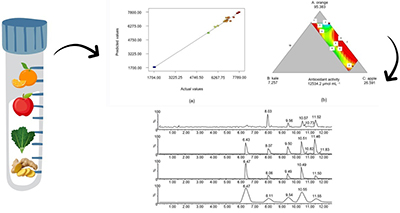
This graphic illustrates the optimization of a mixed juice formula resulting in an optimal blend with high antioxidant activity.
https://dx.doi.org/10.21577/0103-5053.20240060
J. Braz. Chem. Soc. 2024, 35(9), e-20240061, 1-11
Eudragit® L100 Post-Modification via Ugi Multicomponent Reaction
Cássia A. Brito  ; Eduardo M. B. da Silva; Luis P. Icart; Marcos L. Dias
; Eduardo M. B. da Silva; Luis P. Icart; Marcos L. Dias 
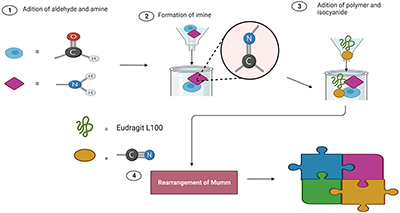
The Ugi multicomponent reaction (MCR) involves four components (aldehyde, amine, isocyanide, and carboxylic acid) to form bisamide. In this study, the reaction utilized a carbohydrate, an aromatic amine, a commercial copolymer, and tert-butyl isocyanide.
https://dx.doi.org/10.21577/0103-5053.20240061
J. Braz. Chem. Soc. 2024, 35(9), e-20240062, 1-11
A Semi-Automated Molecularly Imprinted Polymer Solid-Phase Extraction Method for Catechin Analysis from Jaboticaba (Plinia sp.) Peel Extract Samples by UHPLC-DAD
Alessandra T. Cardoso; Rafael O. Martins  ; Lucas S. Machado
; Lucas S. Machado  ; Lucília Kato; Rosineide C. Simas; Carmen Lúcia Cardoso
; Lucília Kato; Rosineide C. Simas; Carmen Lúcia Cardoso  ; Andréa R. Chaves
; Andréa R. Chaves
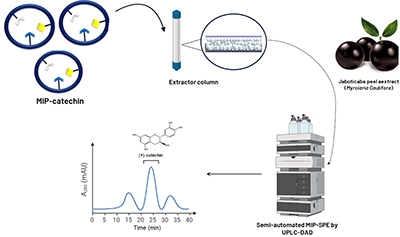
Molecularly imprinted polymers applied for the extraction of catechin from jaboticaba peel samples in a semi-automated analytical approach.
https://dx.doi.org/10.21577/0103-5053.20240062
J. Braz. Chem. Soc. 2024, 35(9), e-20240064, 1-7
Putative Inhibitor of TcCYP51 from a Library of Approved Drugs: A Virtual Screening Study
Luiz Augusto P. Flores-Junior  ; Eldio G. dos Santos
; Eldio G. dos Santos  ; Estela Maris F. Muri
; Estela Maris F. Muri  ; Camilo Henrique S. Lima
; Camilo Henrique S. Lima  ; Luiza Rosaria S. Dias
; Luiza Rosaria S. Dias 
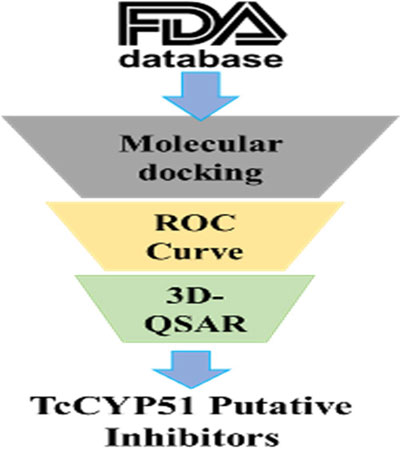
A virtual screening protocol to identify possible Trypanosoma cruzi sterol 14α-demethylase (TcCYP51) inhibitors from U.S. Food and Drug Administration (FDA)-approved drugs using combined computational techniques.
https://dx.doi.org/10.21577/0103-5053.20240064
J. Braz. Chem. Soc. 2024, 35(9), e-20240066, 1-13
Preparation of TiO2/Lignin Composites with Agave sisalana Residue for Bisphenol-A Removal
Aleir J. O. Silva; Franklin D. Xavier; Maria G. da Fonseca; Marta M. da Conceição
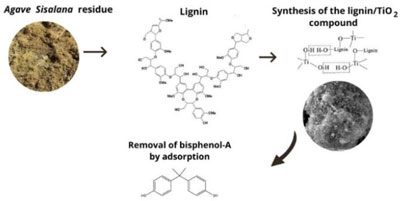
Preparation of lignin/TiO2 composites with Agave sisalana residue applied for bisphenol-A removal. The adsorbent can be used in six cycles, removing over 70% by the third cycle, which indicates good stability.
https://dx.doi.org/10.21577/0103-5053.20240066
J. Braz. Chem. Soc. 2024, 35(9), e-20240067, 1-10
Active Ni-Titanate Nanostructures for Dry Reforming of Methane
Wesley F. Monteiro  ; Vinícius Demétrio da Silva
; Vinícius Demétrio da Silva  ; Michele O. Vieira
; Michele O. Vieira  ; Camila O. Calgaro; Oscar W. Perez-Lopez;
; Camila O. Calgaro; Oscar W. Perez-Lopez;
Marcus Seferin  ; Rosane A. Ligabue
; Rosane A. Ligabue
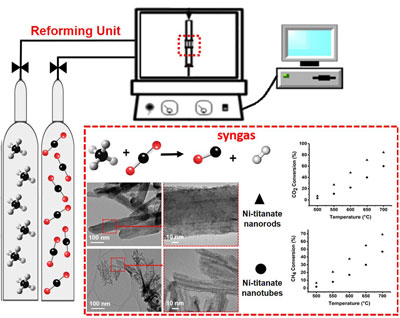
Dry reforming of methane converts CO2 and CH4 into syngas. The calcination at 700 °C results in titanate nanorods. Ni-TNR catalyst enhances CO2 and CH4 conversion with low carbon deposition.
https://dx.doi.org/10.21577/0103-5053.20240067
Short Report J. Braz. Chem. Soc. 2024, 35(9), e-20240046, 1-6
Development of Cross-Linked Gelatin Hydrogel Films Using Tannic Acid as Anti-Aging Active with Skin Care Potential
Gabriele B. de Oliveira; Isadora S. Zamataro; Mariana S. de Oliveira; André S. Gomes; Maria Gabriela A. Barros; Angélica G. Oliveira; Karine Zanella; Caroline C. S. Gonçalves 
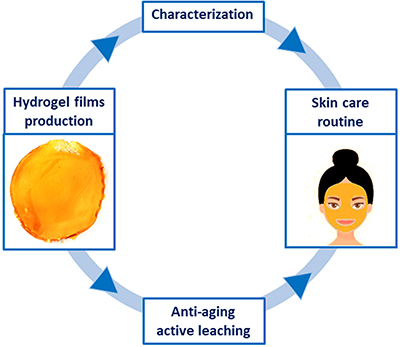
Hydrogel films containing tannic acid (TA) were prepared and characterized by different techniques and the active release was investigated to obtain a suitable material to be applied in skin care routines.
https://dx.doi.org/10.21577/0103-5053.20240046
J. Braz. Chem. Soc. 2024, 35(9), e-20240050, 1-10
Understanding Synthesis Parameters for Thionation of Phosphonates Associated with the Chemical Weapons Convention through Principal Component Analysis
Caio V. N. Borges  ; Leandro B. Bernardo; Samir F. A. Cavalcante
; Leandro B. Bernardo; Samir F. A. Cavalcante  ; Antônio L. S. Lima
; Antônio L. S. Lima 
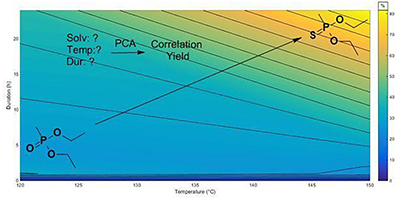
Principal components analysis to determine the parameters impact on thionation by Lawesson's reagent and phosphonates.
https://dx.doi.org/10.21577/0103-5053.20240050
Online version ISSN 1678-4790 Printed version ISSN 0103-5053
Journal of the Brazilian Chemical Society
JBCS Editorial and Publishing Office
University of Campinas - UNICAMP
13083-970 Campinas-SP, Brazil
Free access










